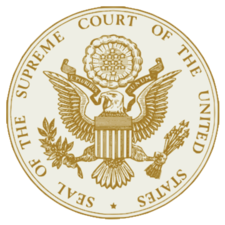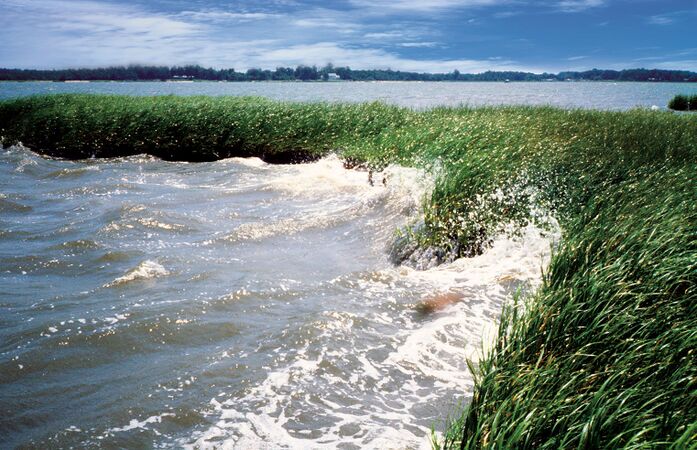Sackett v. Environmental Protection Agency (2012)
 | |
| Sackett v. Environmental Protection Agency | |
| Docket number: 10-1062 | |
| Court: United States Supreme Court | |
| Court membership | |
| Chief Justice John G. Roberts Associate Justices Antonin Scalia Anthony Kennedy • Clarence Thomas Ruth Bader Ginsburg • Stephen G. Breyer Samuel Alito • Sonia Sotomayor • Elena Kagan | |
Sackett v. Environmental Protection Agency (EPA) was decided by the U.S. Supreme Court in March 2012. The court ruled unanimously that individuals subject to a compliance order issued by the Environmental Protection Agency (EPA) under the Clean Water Act can seek judicial review challenging the order under the Administrative Procedure Act of 1946. In addition, the majority opinion concluded that the scope of the EPA's jurisdiction over wetlands under the Clean Water Act remained an open issue to be addressed Congress.[1][2]
Background
- See also: Waters of the United States and Clean Water Act
Facts of the case
Mike and Chantell Sackett bought in 2005 a 0.63-acre area in a residential subdivision in Priest Lake, Idaho. The Sacketts applied for and obtained local building permits for home construction in the area. Beginning in spring 2007, construction on the property commenced when employees of the Sacketts placed gravel and rock on the site to begin construction on the house's foundation. After several days, officials from the Environmental Protection Agency (EPA) and the U.S. Army Corps of Engineers visited the property and told the Sacketts to cease construction work, arguing that the site included wetlands regulated under the Clean Water Act. The Sacketts later received an after-the-fact wetland permit application from the U.S. Army Corps. However, the Sacketts did not complete the application given their concerns about whether their property was a wetland subject to Clean Water Act regulation (the application would have required the Sacketts to affirm that their property fell under Clean Water Act regulation before they could continue construction). Throughout 2007, the Sacketts requested that the EPA provide a written justification for its order to cease construction on the couple's property.[2][3]
EPA compliance order
In November 2007, the EPA issued a compliance order stating that the Sacketts had unlawfully filled in a wetland on their property without a federal permit under the Clean Water Act. According to the act, the EPA can issue a compliance order based on any information available indicating that the act had been violated. The order instructed the Sacketts to remove all gravel and dirt placed on the site during construction and to return the property to its previous condition. The EPA was permitted access the property and the Sacketts' business records to ensure compliance with the agency's order. In addition, failure to comply with the order included civil fines of up to $32,500 per day. The Sacketts requested an administrative hearing in front of the EPA, which was denied.[2][3]
Lawsuit
The Sacketts filed suit in United States District Court in Idaho, arguing that the EPA's order was arbitrary and capricious under the Administrative Procedure Act of 1946. In addition, the Sacketts argued that they were denied procedural due process rights under the Fifth Amendment after they had been denied an administrative hearing by the EPA. Requesting that the lawsuit be dismissed, the EPA argued that its compliance order was not the kind of action subject to judicial review. The district court sided with the EPA and dismissed the suit.[3][4][5]
The Sacketts appealed to the United States Court of Appeals for the 9th Circuit, which affirmed the lower court decision favoring the EPA. The appeals court argued that compliance orders were not subject to judicial review. In addition, the court found that the Sacketts were not denied due process rights under the Fifth Amendment, arguing that the Sacketts were not subject to sanctions from the EPA unless and until the agency decided to enforce its compliance order by filing suit in federal court.[3][4][5]
The Sacketts submitted a petition to the U.S. Supreme Court requesting the court to hear the case. Specifically, the petition requested that the court decide whether compliance orders are subject to judicial review under the Administrative Procedure Act. Further, the petition requested that the court decide whether compliance orders either have legal impact or are warnings that do not impose liability.[3][4][5]
Supreme Court ruling
| Questions considered: 1. Was the EPA's compliance order to the Sacketts a final agency action subject to judicial review under the Administrative Procedure Act? Conclusion: |
In a 9-0 decision, Justice Antonin Scalia wrote the unanimous opinion rejecting the EPA and siding with the Sacketts. Justices Ruth Bader Ginsburg and Samuel Alito wrote concurring opinions.[5]
Question final agency action
Under the Administrative Procedure Act (1946), an agency action must be final before it can be reviewed in federal court. The two-part test to establish whether an agency action is final was codified in prior Supreme Court decisions. First, the court determines whether the order is the culmination of an agency's decisionmaking process. Second, the court determines if the order has legal impact.[5] The EPA argued that its compliance order was not final because it was not the conclusion of the agency's decisionmaking. In addition, the EPA argued that the compliance order did not create legal liability beyond what is prescribed in the Clean Water Act.[5] The majority rejected the EPA's arguments, concluding that the compliance order was a final agency action. Specifically, the majority found that the compliance order represented the end of the EPA's administrative process because the agency had denied the Sacketts an administrative hearing. In addition, the court's majority argued that the compliance order had several legal effects, including the requirement that the Sacketts restore their property to its previous condition or otherwise pay civil fines.[5]
Question of judicial review
The EPA argued that the Clean Water Act precluded judicial review of its compliance order under the Administrative Procedure Act of 1946. However, the court rejected this argument, concluding that the Administrative Procedure Act established a presumption in favor of judicial review of final agency actions.[5] In addition, the EPA argued that allowing judicial review of compliance orders would hinder the agency's enforcement of environmental laws such as the Clean Water Act. The majority rejected this argument, concluding that the presumption in favor of judicial review outweighs concerns about the impact to the agency's day-to-day operations.[5]
Concurring opinions
Justice Ruth Bader Ginsburg joined the unanimous opinion and also wrote a concurrence. Ginsburg argued that the decision set precedent only for the claim that individuals may challenge the EPA's jurisdiction to issue compliance orders under the Administrative Procedure Act, rather than challenging the substance of EPA compliance orders, since the Sacketts did not challenge the terms of the order.[5]
Justice Samuel Alito argued in his concurrence that the scope of the EPA's and U.S. Army Corps of Engineers' jurisdiction under the Clean Water Act was unclear and that Congress should pass legislation clarifying the scope of the agencies' authority. Further, Alito criticized the EPA's treatment of the Sacketts as a violation of due process and property rights.[5]
Analysis
Nina Mendelson, a law professor at the University of Michigan School of Law, argued that the Sackett decision could affect the EPA's enforcement of environmental laws like the Clean Water Act. Mendelson argued that private individuals would be permitted to seek judicial review of the EPA's jurisdiction over waterways and wetlands. As a result, Mendelson concluded, the EPA's ability to enforce the Clean Water Act could be hindered due to the need to address legal challenges to its compliance orders. In addition, Mendelson argued that Congress should amend the Clean Water Act to clarify how precisely judicial review should apply to the EPA's jurisdiction to issue compliance orders.[6]
A 2012 report by American Bar Association concluded that individuals could potentially challenge EPA compliance orders issued under the Clean Air Act under the Sackett decision. The report's authors argued that the Clean Air Act and Clean Water Act contain similar legal structures. Subsequently, the report's authors concluded that because the Clean Air Act does not explicitly prohibit judicial review of the EPA's compliance orders, the Sackett decision may allow individuals to challenge similar compliance orders issued under the Clean Water Act.[7]
Jonathan Adler, professor of law at the Case Western Reserve University School of Law, argued that the Sackett decision was a first step in establishing Fifth Amendment procedural due process rights for individuals under the Clean Water Act.[8]
See also
- Supreme Court of the United States
- U.S. Environmental Protection Agency
- Implementation of the Clean Water Act
- National Pollutant Discharge Elimination System
External links
Footnotes
- ↑ The Volokh Conspiracy, "Thoughts on Sackett v. EPA (by Jonathan H. Adler)," March 21, 2012
- ↑ 2.0 2.1 2.2 Oyez Project, "Sackett v. EPA," accessed April 15, 2015
- ↑ 3.0 3.1 3.2 3.3 3.4 The New York Times, "Idaho Couple's Permit Fight Drags Wetlands Back to Supreme Court," September 19, 2011
- ↑ 4.0 4.1 4.2 Marten Law, "Closely Watched Sackett Case Argued in Supreme Court," January 17, 2012
- ↑ 5.00 5.01 5.02 5.03 5.04 5.05 5.06 5.07 5.08 5.09 5.10 Google Scholar, "Chantell Sackett, et vir, Petitioners v. Environmental Protection Agency, et al.," March 21, 2012
- ↑ Center for Progressive Reform, "SCOTUS Decision in Sackett v. EPA Weakens Government's Ability to Respond to Urgent Threats to Water Quality," March 21, 2012
- ↑ American Bar Association, "Sackett v. EPA: Implications for administrative compliance," accessed April 15, 2015
- ↑ The Volokh Conspiracy, "Thoughts on Sackett v. EPA," March 21, 2015
| |||||||||||




